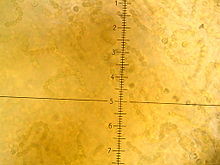Fat choy
| Fat choy | |
|---|---|

| |
| Nostoc flagelliformeunder a microscope | |
| Scientific classification | |
| Domain: | Bacteria |
| Phylum: | Cyanobacteria |
| Class: | Cyanophyceae |
| Order: | Nostocales |
| Family: | Nostocaceae |
| Genus: | Nostoc |
| Species: | N. flagelliforme
|
| Binomial name | |
| Nostoc flagelliforme | |
| Synonyms[1] | |
| Fat choy | |||||||||||||||
|---|---|---|---|---|---|---|---|---|---|---|---|---|---|---|---|
 | |||||||||||||||
| Traditional Chinese | Tảo | ||||||||||||||
| Simplified Chinese | Tảo | ||||||||||||||
| Literal meaning | "hair vegetable" | ||||||||||||||
| |||||||||||||||
| Alternative Chinese name | |||||||||||||||
| Traditional Chinese | Đầu mao đồ ăn | ||||||||||||||
| |||||||||||||||
Fat choy(traditional Chinese:Tảo;simplified Chinese:Tảo;pinyin:fàcài;Jyutping:faat³ coi³;Nostoc flagelliforme) is a terrestrialcyanobacterium(a type ofphotosyntheticbacteria) that is used as a vegetable inChinese cuisine.When dried, the product has the appearance of blackhair.For that reason, its name in Chinese means "hair vegetable". When soaked, fat choy has a soft texture which is like very finevermicelli.
Production
[edit]Fat choy grows on the ground in theGobi Desertand theQinghai Plateau.Over-harvestingon the Mongolian steppes has furtherederosionanddesertificationin those areas. The Chinese government has limited its harvesting, which has caused its price to increase.[2]
Commercially available fat choy has been found to be adulterated with strands of a non-cellular starchy material, with other additives and dyes.[2][3]Real fat choy is dark green in color, while the counterfeit fat choy appears black.[2]
Use
[edit]China
[edit]Its name inCantonesesound the same as a Cantonese phrase meaning "struck it rich" (though the second syllable,coi,has a differenttone) -- this is found, for example, in the Cantonese saying, "Gung1 hei2 faat3 coi4"(Cung hỉ phát tài,meaning "wishing you prosperity" ), often proclaimed duringChinese New Year.Therefore, it is a popular ingredient for the Chinese New Year, like in thereunion dinner.It is enjoyed as an alternative tocellophane noodles.[citation needed]It is mostly used inCantonese cuisineandBuddhist cuisine.It is sometimes used as ahot potingredient.
Due to its high price, fat choy is considered a luxury food, and only used in limited occasions. It is not eaten as a staple.[4]
Vietnam
[edit]Fat choy is also used inVietnamese cuisine.It is calledtóc tiênortóc thiêng(literally"angel's hair" ) inVietnamese.
Health effects
[edit]N. flagelliformehas no nutritional value,[dubious–discuss]and also containsbeta-N-methylamino-L-alanine(BMAA), a toxicamino acidthat could affect the normal functions of nerve cells and is linked to degenerative diseases such as ALS,Alzheimer's,Parkinson's,anddementia.[5]Not all realfat choysamples contains BMAA according to a 2009 study, with the maximum concentration being 658.5ng/g. Imitationfat choydoes not contain BMAA.[4]
Across a 28-day duration, laboratory rats fedN. flagelliformeand the control group did not exhibit significant differences in any toxicological parameters.[6]
The algae and its extracts reduce the inflammatory action of white blood cells, specifically macrophages and splenocytes,in vitro.[7]
References
[edit]- ^abCalvo-Pérez, Juan Diego; Molinari-Novoa, Eduardo A.;Guiry, Michael D.(23 March 2016)."Validation ofNostoc flagelliforme(Nostocaceae, Cyanobacteria) "(PDF).Notulae Algarum(2): 1–2.ISSN2009-8987.Retrieved15 January2019.
- ^abc"The standard.hk".Archived fromthe originalon November 22, 2007.Retrieved22 October2018.
- ^"Waynesword".Archived fromthe originalon 2004-10-10.Retrieved2004-11-07.
- ^abRoney, BR; Renhui, L; Banack, SA; Murch, S; Honegger, R; Cox, PA (2009). "Consumption of fa cai Nostoc soup: a potential for BMAA exposure from Nostoc cyanobacteria in China?".Amyotrophic Lateral Sclerosis.10(Suppl 2): 44–9.doi:10.3109/17482960903273031.PMID19929731.S2CID2893117.
- ^The standard.hk. Mimi Lau, January 30, 2007,Ban sought on Lunar delicacyArchivedNovember 22, 2007, at theWayback Machine
- ^Takenaka 1998.
- ^Ku, Lee (2013)."Edible blue-green algae reduce the production of pro-inflammatory cytokines by inhibiting NF-κB pathway in macrophages and splenocytes".Biochimica et Biophysica Acta (BBA) - General Subjects.1830(4): 2981–2988.doi:10.1016/j.bbagen.2013.01.018.PMC3594481.PMID23357040.
This article includes a list of generalreferences,butit lacks sufficient correspondinginline citations.(September 2023) |
- But, Paul Pui-Hay; Cheng, Ling; Chan, Pui Kwan; Lau, David Tai-Wai; But, Joyce Wing-Hin (2002). "Nostoc flagelliformeand faked items retailed in Hong Kong ".Journal of Applied Phycology.14(2): 143–145.doi:10.1023/a:1019518329032.ISSN0921-8971.S2CID6195505.
- Takenaka, H.; Yamaguchi, Y.; Sakaki, S.; Watarai, K.; Tanaka, N.; Hori, M.; Seki, H.; Tsuchida, M.; Yamada, A.; Nishimori, T.; Morinaga, T. (1 December 1998)."Safety evaluation of Nostoc flagelliforme (nostocales, Cyanophyceae) as a potential food".Food and Chemical Toxicology (United Kingdom).36(12): 1073–1077.doi:10.1016/S0278-6915(98)00089-1.ISSN0278-6915.PMID9862649.Archived fromthe originalon 22 October 2018.Retrieved22 October2018.
External links
[edit]- "Cyanobacteria Photos".waynesword.palomar.edu.Archived fromthe originalon 10 October 2004.Retrieved22 October2018.
- "food for thought".sg.bcmagazine.net. 1 February 2004. Archived fromthe originalon 1 February 2004.Retrieved22 October2018.
